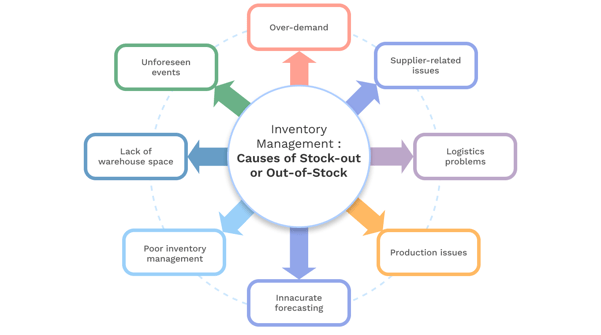Innovative Inventory Planning Techniques Every Retailer Needs
Innovative Inventory Planning Techniques Every Retailer Needs
In retail, having the right product at the right time is crucial. Poor inventory planning can lead to lost sales, frustrated customers, and wasted resources.
Imagine a customer walking into your store, excited to purchase a popular item, only to find it out of stock. Or consider the financial burden of excess inventory taking up valuable storage space. Effective inventory planning is the key to avoiding these issues and ensuring smooth operations.
This article will explore innovative inventory planning techniques that can transform your retail operations. By leveraging modern solutions like big data, AI, and real-time tracking, you can maintain optimal stock levels, reduce costs, and enhance customer satisfaction.
Quick Takeaways
- Efficient inventory planning reduces costs by maintaining optimal stock levels, minimizing the risk of stockouts and excess inventory.
- Accurate inventory planning ensures product availability, increasing customer loyalty and repeat business.
- Poor inventory management can lead to significant financial losses, highlighting the need for effective planning.
- Leveraging big data and predictive analytics allows retailers to make informed decisions, optimizing inventory levels and improving overall efficiency.
The Importance of Inventory Planning in Retail
Without effective inventory planning, retailers can face a range of issues, from stockouts to overstocking. Any disruption in the process can negatively impact profitability and customer satisfaction.

One of the significant benefits of efficient inventory planning is reducing costs. By maintaining optimal inventory levels, businesses can lower the costs associated with holding excess stock and minimize the risk of stockouts. According to a recent study, reducing stockouts and overstocks can lower inventory costs by up to 10%.
Accurate inventory planning also helps improve customer satisfaction. When customers find the products they need consistently available, their loyalty increases. This ensures repeat business and positive word-of-mouth, which are invaluable for retail growth.
The impact of poor inventory management is substantial. For instance, the cost of inventory distortion—overstocking or understocking—amounted to $349 billion for US and Canadian retailers in 2022. This highlights the financial significance of getting inventory planning right.
Data-Driven Inventory Planning
Retailers can no longer rely solely on traditional methods for inventory planning. Data-driven inventory planning uses vast amounts of data to make informed decisions, leading to more accurate forecasts and optimized stock levels.
Role of Big Data
Big data plays a crucial role in modern inventory planning. It involves collecting and analyzing data from various sources, including:
- Sales history
- Market trends
- Customer behavior
This comprehensive approach allows retailers to predict demand more accurately and adjust their inventory accordingly. According to a Bain & Company survey, 56% of companies increased their investment in demand forecasting and predictive planning to leverage these insights.

Predictive Analytics
Predictive analytics is a key component of data-driven inventory planning. By analyzing historical data and identifying patterns, retailers can forecast future demand with greater precision. This helps in minimizing stockouts and reducing excess inventory.
Companies using predictive analytics have reported improvements in their inventory management, leading to higher efficiency and better customer satisfaction.
AI-Powered Inventory Management
AI-powered inventory management represents a significant leap forward in how retailers handle their stock. By leveraging artificial intelligence and machine learning, businesses can achieve unprecedented levels of efficiency, accuracy, and responsiveness in their inventory processes.

AI and Machine Learning Integration
Artificial intelligence (AI) and machine learning (ML) are transforming inventory management by enabling systems to learn from data and make autonomous decisions. These technologies analyze vast amounts of data to identify patterns, predict demand, and optimize inventory levels in real-time.
For instance, AI can help forecast which products will be popular during certain seasons, allowing retailers to adjust their stock accordingly and avoid both overstocking and stockouts.
Benefits of AI in Inventory Management
The integration of AI in inventory management offers several key benefits:
- Improved Accuracy: AI systems can process and analyze data faster and more accurately than humans, reducing errors in inventory counts and demand forecasts.
- Real-Time Insights: AI provides real-time data and insights, enabling retailers to make informed decisions quickly. This helps in responding to market changes and customer demands promptly.
- Automation: AI can automate routine tasks such as reordering stock, tracking inventory levels, and managing supply chains. This not only saves time but also allows staff to focus on more strategic activities.
For example, a retailer using Hypersonix’s AI solutions reported significant improvements in their inventory management. By leveraging AI, they could predict seasonal demand spikes and adjust their inventory accordingly. This led to a 16.8% lift in profits and a notable reduction in overstock costs and stockouts, ultimately boosting their profitability and customer satisfaction.
Enhancing Inventory Visibility
Enhancing inventory visibility is crucial for modern retail operations. Real-time tracking and data integration across various channels ensure that retailers have an accurate and comprehensive view of their inventory at all times.
Real-Time Tracking
Real-time inventory tracking allows retailers to monitor their stock levels continuously. Technologies like RFID (Radio Frequency Identification) and IoT (Internet of Things) sensors provide instant updates on the status and location of products. This level of visibility helps retailers respond quickly to changes in demand, reducing the risk of stockouts and overstocking.
Omnichannel Integration
Omnichannel integration ensures that inventory data is synchronized across physical stores, online platforms, and warehouses. This integration helps retailers provide accurate stock information to customers, improving their shopping experience and increasing sales.
For example, integrating inventory systems with e-commerce platforms allows for accurate stock counts, reducing the likelihood of selling out-of-stock items.
Benefits of Enhanced Inventory Visibility
- Improved Customer Satisfaction: Accurate inventory information ensures that customers can find the products they need, whether shopping in-store or online.
- Increased Efficiency: Real-time tracking and data integration streamline inventory management processes, reducing manual errors and saving time.
- Cost Reduction: Enhanced visibility helps in optimizing stock levels, reducing excess inventory and associated holding costs.
- Better Decision Making: Access to real-time data and predictive insights allows retailers to make informed decisions about purchasing, stocking, and selling strategies.
By leveraging advanced technologies and integrating data across channels, retailers can achieve a more efficient and responsive inventory management system, ultimately driving better business outcomes.
Maximize Inventory Planning for Retail Success Today with Hypersonix
Data-driven inventory planning is a necessity in the retail space. By leveraging big data and predictive analytics, retailers can make informed decisions, optimize their inventory, and ultimately enhance customer satisfaction and profitability.
Hypersonix provides advanced AI-powered solutions that enhance data-driven inventory planning. Our platform integrates data from various sources, offering real-time insights and predictive analytics to optimize inventory levels. Retailers using Hypersonix can achieve better inventory accuracy, reduce costs, and improve overall efficiency. Learn about Inventory AI
Discover how Hypersonix’s AI-driven inventory planning solutions can optimize your stock management. Book a demo today to boost your retail efficiency!






